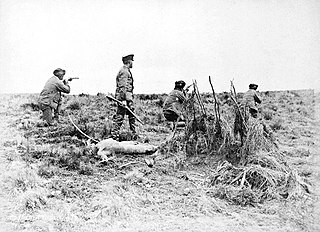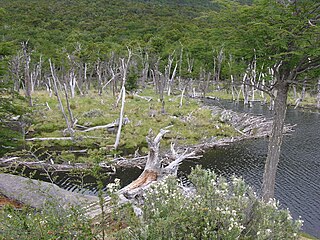
Tierra del Fuego is an archipelago off the southernmost tip of the South American mainland, across the Strait of Magellan.

The guanaco is a camelid native to South America, closely related to the llama. Guanacos are one of two wild South American camelids; the other species is the vicuña, which lives at higher elevations.

Isla Grande de Tierra del Fuego also formerly Isla de Xátiva is an island near the southern tip of South America from which it is separated by the Strait of Magellan. The western portion (61.4%) of the island is in Chile, while the eastern portion is in Argentina. It forms the major landmass in an extended group of islands or archipelago also known as Tierra del Fuego.

Beagle Channel is a strait in the Tierra del Fuego Archipelago, on the extreme southern tip of South America between Chile and Argentina. The channel separates the larger main island of Isla Grande de Tierra del Fuego from various smaller islands including the islands of Picton, Lennox and Nueva; Navarino; Hoste; Londonderry; and Stewart. The channel's eastern area forms part of the border between Chile and Argentina and the western area is entirely within Chile.

Nothofagus betuloides, Magellan's beech or guindo, is a tree native to southern Patagonia.

Tierra del Fuego National Park is a national park on the Argentine part of the island of Tierra del Fuego, within Tierra del Fuego Province in the ecoregion of Patagonic Forest and Altos Andes, a part of the subantarctic forest. Established on 15 October 1960 under the Law 15.554 and expanded in 1966, it was the first shoreline national park to be established in Argentina.

The Selk'nam genocide refers to the systematic extermination of the Selk'nam or Ona people, one of three indigenous tribes populating Tierra del Fuego in South America, from the second half of the 19th to the early 20th century. The genocide spanned a period of between ten and fifteen years. The Selk'nam had an estimated population of 4,000 people around the 1880s but saw their numbers reduced to 500 by the early 1900s.

The governments of Chile and Argentina are attempting to eradicate the North American beaver in the Tierra del Fuego area at the southernmost tip of South America. This non-native species was introduced in 1946 as a potential source of commercial fur trading. When the putative fur trade industry failed, the beavers became problematic and the governments agreed to intervene to wipe them out. A June 2011 NPR report stated that the beavers have caused millions of dollars in damages. According to Nature, this plan is the largest eradication project ever attempted.
Penicillium alicantinum is a fungus species of the genus of Penicillium which was isolated from the atmosphere in Madrid.

Yendegaia National Park is located in Tierra del Fuego in the Magallanes y la Antártica Chilena Region of Chile and contains 150,612 ha of mountainous terrain and Valdivian temperate rain forest. It borders the Alberto de Agostini National Park and Tierra del Fuego National Park.
Penicillium aragonense is an anamorph fungus species of the genus of Penicillium.
Penicillium jugoslavicum is an anamorph species of the genus of Penicillium which was isolated from seeds of Helianthus annuus L.
Penicillium lapatayae is an anamorph species of the genus of Penicillium which was isolated from Tierra del Fuego in Chile. Penicillium lapatayae produces (-)-lapatin B
Penicillium malacaense is an anamorph species of the genus of Penicillium.
Penicillium murcianum is an anamorph species of the genus Penicillium.
Penicillium onobense is an anamorph species in the genus Penicillium which was isolated from beech forest in Navarra in Spain.
Penicillium siamense is an anamorph species of fungus in the genusPenicillium which was isolated from forest soil in Thailand.
Penicillium tarraconense is an anamorph species of fungus in the genus Penicillium which was isolated from air in Madrid in Spain.
Penicillium vasconiae is a species of fungus in the genus Penicillium which was isolated in Madrid in Spain.

The North American beaver is an invasive species in the southern tip of Patagonia, an area called Tierra del Fuego. Tierra del Fuego is a large island and encompasses land belonging to both Chile and Argentina, and as such, policies and actions to control and eradicate the species has mostly been binational. The beavers were introduced to the area in 1946 due to an effort by the Argentine government to establish a fur trade in the region. Ever since the introduction event, the beavers have spread throughout most of Tierra del Fuego and have even been recently spotted on the Brunswick Peninsula, mainland Chile.








